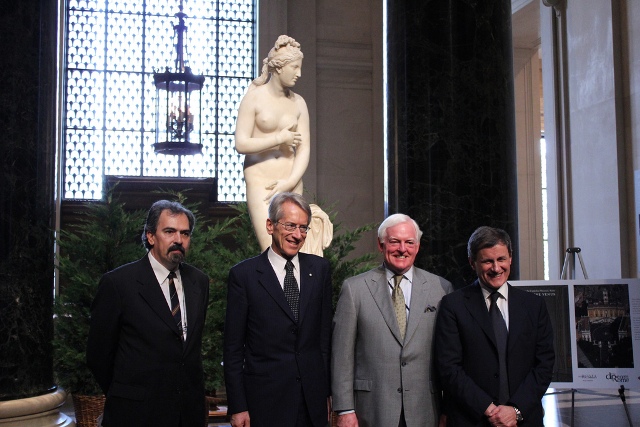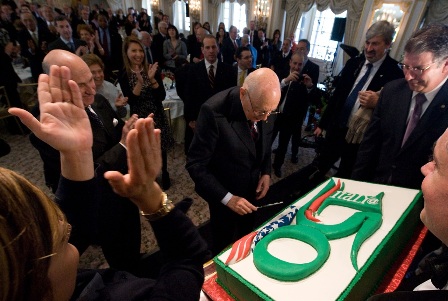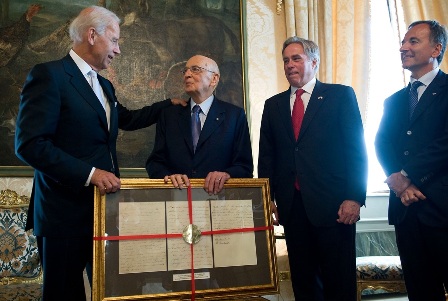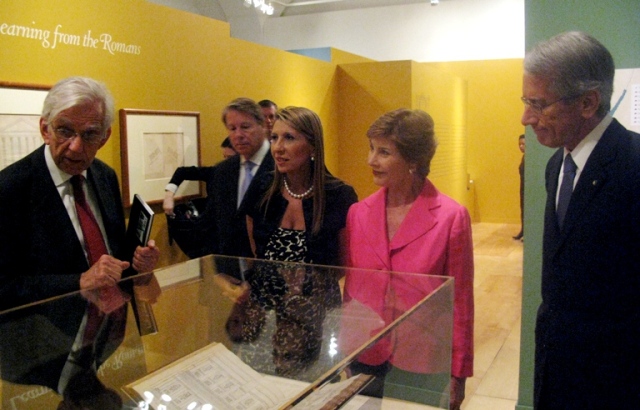One of the most significant benchmarks in Italian history is the country’s unification, which took place on March 17, 1861, when Victor Emmanuel II, of the House of Savoy and the King of Sardinia, was proclaimed the first king of the country, in a move that brought together most of the land currently known as Italy. The unification was the result of a long and sometimes arduous struggle known as “Il Risorgimento” or “the resurgence” of political ideas previously espoused in the late 18th century. As with all movements, varying personalities and leaders emerged who defined success as everything from complete removal of all monarchial systems, including the papacy, to a constitutional form of monarchy under the House of Savoy.
One of the central actors in the drama deciding soon-to-be Italy’s future was Giuseppe Garibaldi. His military contributions both in South America and Italy earned him the moniker “Hero of the Two Worlds.” His reputation and the time he spent in exile in New York rooming with Italian scientist and later inventor of the telephone, Antonio Meucci, captivated a wide audience including—according to recently discovered documents—President Abraham Lincoln. President Lincoln appears to have thought so much of Garibaldi that he offered him command of the Northern Union Army. Though Garibaldi declined, a unit from New York comprised partially of Italian-Americans bore his name during the American Civil War.
Though the monarchy of the House of Savoy would be abolished by the constitutional referendum approved on June 2, 1946, under which Italy became a republic, the Italian unification was an important step for a land that until then had been governed by papal and feudal city-states.
As such, the Republic of Italy that we know today has only existed since the end of World War II and the unified Italian monarchy prior to that was established only 150 years ago making “Italy” a much younger country than the United States despite the longevity of the people on the peninsula.
“As a young Nation, Italy has matured very quickly over the past 150 years, thanks to the set of values inherited from what you call ‘Italy, the idea,”’ expressed Giulio Terzi di Sant’Agata, Ambassador of Italy to the United States. “Our ‘ancient’ tradition of democracy, rule of law, equal opportunity is mirrored today in our commitment to effectively carry out our global responsibilities.”
To mark the 150th anniversary of the Italian unification, celebratory events are being held around the United States to mark this auspicious occasion.
Many of the events have taken place in Washington, DC, which recently entered into a Sister City agreement with the Italian capital of Rome.
As Reta Jo Lewis, Special Representative for Global Intergovernmental Affairs at the U.S. State Department said at the ceremony to launch the agreement, “Washington, DC and Rome make what could be described as a historic ‘power couple.’ Throughout world history, some of the most significant events have happened in these two cities…Thus I believe that this Sister City relationship between Washington, DC and Rome will form strong bonds across a wide range of issues including culture, history, and politics.”
Ms. Lewis’ allusion to the similarities and common bonds between the capital cities of the U.S. and Italy as well as the countries in general is accurate. While the boundaries of the land commonly known as Italy have changed over the centuries, what has remained unchanged is the common thread connecting the two countries. As U.S. House Democratic Leader and Italian American Nancy Pelosi said of the 150th anniversary of Italy’s unification, “America is a land discovered by an Italian, named for an Italian, and built by millions of Italian Americans. The Italian-American community means there are literally millions of bridges between our two nations.”
In addition to the references from Pelosi to Christopher Columbus and Amerigo Vespucci, there are countless other “bridges” connecting the two countries.
Italian surnames pervade the history of the world as well as the present. Names like Columbus, Vespucci, Vivaldi, Alighieri, Galileo, Michelangelo, Di Maggio, Pacino, DeNiro, and Giuliani are known to many because of their aptitude and accomplishments in their field. There are of course lesser-known names whose contributions are in no way diminished by their lack of notoriety.
One such example is Italian Renaissance Architect Andrea Palladio, whose work gave birth to the Palladian style, which greatly influenced Thomas Jefferson in the design and construction of his famous home, Monticello. Palladio’s work can also be seen in another building where Jefferson resided for a period of time. The windows of the east and west side of the White House in Washington, DC are Palladian style and are “very significant to the architecture of the building,” as pointed out by National Italian American Foundation Board Member and former Chief of Staff to First Lady Laura Bush, Anita Bevacqua McBride. “Those two large windows helped to flood the White House private residence with light. Beneath the Palladian window on the west side was a favorite place for Mrs. Bush to sit and read and where we would often meet,” McBride recalled.
There is also Constantino Brumidi who spent much of the last twenty-five years of his life working in the United States Capitol. Visitors today can see Brumidi’s handiwork in everything from the Apotheosis of Washington in the eye of the rotunda to the Brumidi Corridors dotted with his elegant frescoes on the first floor of the Senate Wing.
Additionally, Italo Marchioni, an Italian American immigrant living in New Jersey is credited with inventing the ice cream cone in 1896.
Or perhaps, Italian inventor Guglielmo Marconi who received what would be the first transatlantic radio signals. In 1901, the station built and named for him would become one of the first to receive distress signals coming off of the ill-fated Titanic.
More recently, in 1922, Attilio Piccirilli, an immigrant from Naples and his five brothers contributed a widely recognized sculpture to Washington, DC tourists—the statue of Abraham Lincoln at the Lincoln Memorial on the National Mall. The Piccirilli brothers were also commissioned to contribute the two lions on the steps of the New York Public Library.
The contributions continue today as pointed out by Ambassador Terzi, who noted there are “Fifteen thousand Italian, or of Italian origin, scientists working in the United States today according to the National Science Foundation; seventy physicists from Italian universities are employed in the greatest particle accelerator in the United States, which takes its name from an Italian who is famous in America and in the rest of the world.” He was speaking of course of Enrico Fermi.
Parallels and similarities have long existed between the U.S. and Italy. In 1861 as Italy was fighting for unification, the Civil War was breaking out in the United States. As National Italian American Foundation Chairman Jerry Colangelo explained, “In the same year 150 years ago when the United States was struggling through civil war to remain united, Italy was struggling to become united. Both succeeded, attesting again to the long and enduring bond between these two nations and their people.”
The division that was brought to light between the United States’ more industrial North and the agricultural South during the Civil War is not unique to this country. The same divisions have long existed in Italy, showing up regularly in polls and public sentiments and at the ballot box as was evidenced during the 1946 constitutional referendum in which a chasm emerged between the more industrially advanced and focused North, where the Republic garnered a clear majority of the votes, and the more agrarian centered South, where the monarchy gained support. To some extent, these differences are still widely recognizable today.
While these issues may have seemed local at the time, they were actually part of a broader movement going on around the world. “Both the American Civil War and the Italian Risorgimento (as well as the unification of Germany and the Meiji Restoration in Japan) took place in an era in which nationalism unified countries at the expense of old elites,” explained Dr. Jeffrey Rutherford, Assistant Professor of History at Wheeling Jesuit University.
The commonalities that have aligned the fates of the two nations extend deeper into the past and prior to their quests for unity in the late 1800’s.
“Italy’s presence in the U.S. is much older than its 150 years as a unified nation. Our peoples’ common heritage and ties did start long before 1861 and even 1776. Our affinities are embedded in history, in the quintessential values of the Risorgimento...The same ideals shaped the political thought which gave birth, over two and a half centuries ago, to a deep, shared idea of democracy and rule of law which both American and Italian institutions were first based, and later developed upon,” stated Ambassador Terzi.
In the 18th century, a series of correspondence volleyed back and forth across the Atlantic between two men who never met but whose ideals and ideas about liberty and legality bound them to one another. American Founding Father Ben Franklin and Italian philosopher Gaetano Filangieri corresponded regularly as the American Republic was in its nascent stages with Filangieri’s thoughts and references contributing to the U.S. Constitution. Filangieri’s area of interest was the law and he is credited with the spirit behind the U.S. Constitution’s sixth amendment regarding the rights of the accused.
The intellectual fingerprints of other Italians can be found on the U.S. Constitution including Filippo Mazzei to whom the phrase “All men are created equal” has been attributed.
“I call it a shared identity, whose seeds were planted in the times of Ancient Rome, grew through the Renaissance and flowered with the Enlightenment and the Risorgimento,” said Ambassador Terzi. “The Founding Fathers wrote the Constitution looking to the Republica Romana as a model and for its values of democracy, rule of law, freedom and respect for human dignity. Together, Italy and the U.S. are sparing no efforts to allow other countries and peoples to pursue the same goals.”
As these examples demonstrate, long before Twitter or YouTube made the world seem smaller, the tide of idealism and the wave of progress still managed to carry good ideas around the globe.
As Victor Hugo once stated, “There is nothing more powerful than an idea whose time has come.”
Italy and America are linked not only by their individuals but by the ideas they espoused share common bonds that are the foundation for their collaborations today.
|
|
|
|
During his visit to Rome on the occasion of the celebrations of Italy’s National Day and the 150th Anniversary of the Country’s Unification, US Vice President Joe Biden presented President Giorgio Napolitano with a copy of the letter that Giuseppe Garibaldi wrote to US President Abraham Lincoln. Photo courtesy of the Italian Embassy in Washington, DC. |
Ambassador Giulio Terzi and Former First Lady Laura Bush tour the exhibition “Palladio and His Legacy” at the National Building Museum, one of the very first events of Italy@150 in Washington, under the Auspices of the Italian President. Photo courtesy of the Italian Embassy in Washington, DC. |


a global affairs media network
Bound by Shared Ideals: Italy’s 150th Anniversary Celebration

July 14, 2011
One of the most significant benchmarks in Italian history is the country’s unification, which took place on March 17, 1861, when Victor Emmanuel II, of the House of Savoy and the King of Sardinia, was proclaimed the first king of the country, in a move that brought together most of the land currently known as Italy. The unification was the result of a long and sometimes arduous struggle known as “Il Risorgimento” or “the resurgence” of political ideas previously espoused in the late 18th century. As with all movements, varying personalities and leaders emerged who defined success as everything from complete removal of all monarchial systems, including the papacy, to a constitutional form of monarchy under the House of Savoy.
One of the central actors in the drama deciding soon-to-be Italy’s future was Giuseppe Garibaldi. His military contributions both in South America and Italy earned him the moniker “Hero of the Two Worlds.” His reputation and the time he spent in exile in New York rooming with Italian scientist and later inventor of the telephone, Antonio Meucci, captivated a wide audience including—according to recently discovered documents—President Abraham Lincoln. President Lincoln appears to have thought so much of Garibaldi that he offered him command of the Northern Union Army. Though Garibaldi declined, a unit from New York comprised partially of Italian-Americans bore his name during the American Civil War.
Though the monarchy of the House of Savoy would be abolished by the constitutional referendum approved on June 2, 1946, under which Italy became a republic, the Italian unification was an important step for a land that until then had been governed by papal and feudal city-states.
As such, the Republic of Italy that we know today has only existed since the end of World War II and the unified Italian monarchy prior to that was established only 150 years ago making “Italy” a much younger country than the United States despite the longevity of the people on the peninsula.
“As a young Nation, Italy has matured very quickly over the past 150 years, thanks to the set of values inherited from what you call ‘Italy, the idea,”’ expressed Giulio Terzi di Sant’Agata, Ambassador of Italy to the United States. “Our ‘ancient’ tradition of democracy, rule of law, equal opportunity is mirrored today in our commitment to effectively carry out our global responsibilities.”
To mark the 150th anniversary of the Italian unification, celebratory events are being held around the United States to mark this auspicious occasion.
Many of the events have taken place in Washington, DC, which recently entered into a Sister City agreement with the Italian capital of Rome.
As Reta Jo Lewis, Special Representative for Global Intergovernmental Affairs at the U.S. State Department said at the ceremony to launch the agreement, “Washington, DC and Rome make what could be described as a historic ‘power couple.’ Throughout world history, some of the most significant events have happened in these two cities…Thus I believe that this Sister City relationship between Washington, DC and Rome will form strong bonds across a wide range of issues including culture, history, and politics.”
Ms. Lewis’ allusion to the similarities and common bonds between the capital cities of the U.S. and Italy as well as the countries in general is accurate. While the boundaries of the land commonly known as Italy have changed over the centuries, what has remained unchanged is the common thread connecting the two countries. As U.S. House Democratic Leader and Italian American Nancy Pelosi said of the 150th anniversary of Italy’s unification, “America is a land discovered by an Italian, named for an Italian, and built by millions of Italian Americans. The Italian-American community means there are literally millions of bridges between our two nations.”
In addition to the references from Pelosi to Christopher Columbus and Amerigo Vespucci, there are countless other “bridges” connecting the two countries.
Italian surnames pervade the history of the world as well as the present. Names like Columbus, Vespucci, Vivaldi, Alighieri, Galileo, Michelangelo, Di Maggio, Pacino, DeNiro, and Giuliani are known to many because of their aptitude and accomplishments in their field. There are of course lesser-known names whose contributions are in no way diminished by their lack of notoriety.
One such example is Italian Renaissance Architect Andrea Palladio, whose work gave birth to the Palladian style, which greatly influenced Thomas Jefferson in the design and construction of his famous home, Monticello. Palladio’s work can also be seen in another building where Jefferson resided for a period of time. The windows of the east and west side of the White House in Washington, DC are Palladian style and are “very significant to the architecture of the building,” as pointed out by National Italian American Foundation Board Member and former Chief of Staff to First Lady Laura Bush, Anita Bevacqua McBride. “Those two large windows helped to flood the White House private residence with light. Beneath the Palladian window on the west side was a favorite place for Mrs. Bush to sit and read and where we would often meet,” McBride recalled.
There is also Constantino Brumidi who spent much of the last twenty-five years of his life working in the United States Capitol. Visitors today can see Brumidi’s handiwork in everything from the Apotheosis of Washington in the eye of the rotunda to the Brumidi Corridors dotted with his elegant frescoes on the first floor of the Senate Wing.
Additionally, Italo Marchioni, an Italian American immigrant living in New Jersey is credited with inventing the ice cream cone in 1896.
Or perhaps, Italian inventor Guglielmo Marconi who received what would be the first transatlantic radio signals. In 1901, the station built and named for him would become one of the first to receive distress signals coming off of the ill-fated Titanic.
More recently, in 1922, Attilio Piccirilli, an immigrant from Naples and his five brothers contributed a widely recognized sculpture to Washington, DC tourists—the statue of Abraham Lincoln at the Lincoln Memorial on the National Mall. The Piccirilli brothers were also commissioned to contribute the two lions on the steps of the New York Public Library.
The contributions continue today as pointed out by Ambassador Terzi, who noted there are “Fifteen thousand Italian, or of Italian origin, scientists working in the United States today according to the National Science Foundation; seventy physicists from Italian universities are employed in the greatest particle accelerator in the United States, which takes its name from an Italian who is famous in America and in the rest of the world.” He was speaking of course of Enrico Fermi.
Parallels and similarities have long existed between the U.S. and Italy. In 1861 as Italy was fighting for unification, the Civil War was breaking out in the United States. As National Italian American Foundation Chairman Jerry Colangelo explained, “In the same year 150 years ago when the United States was struggling through civil war to remain united, Italy was struggling to become united. Both succeeded, attesting again to the long and enduring bond between these two nations and their people.”
The division that was brought to light between the United States’ more industrial North and the agricultural South during the Civil War is not unique to this country. The same divisions have long existed in Italy, showing up regularly in polls and public sentiments and at the ballot box as was evidenced during the 1946 constitutional referendum in which a chasm emerged between the more industrially advanced and focused North, where the Republic garnered a clear majority of the votes, and the more agrarian centered South, where the monarchy gained support. To some extent, these differences are still widely recognizable today.
While these issues may have seemed local at the time, they were actually part of a broader movement going on around the world. “Both the American Civil War and the Italian Risorgimento (as well as the unification of Germany and the Meiji Restoration in Japan) took place in an era in which nationalism unified countries at the expense of old elites,” explained Dr. Jeffrey Rutherford, Assistant Professor of History at Wheeling Jesuit University.
The commonalities that have aligned the fates of the two nations extend deeper into the past and prior to their quests for unity in the late 1800’s.
“Italy’s presence in the U.S. is much older than its 150 years as a unified nation. Our peoples’ common heritage and ties did start long before 1861 and even 1776. Our affinities are embedded in history, in the quintessential values of the Risorgimento...The same ideals shaped the political thought which gave birth, over two and a half centuries ago, to a deep, shared idea of democracy and rule of law which both American and Italian institutions were first based, and later developed upon,” stated Ambassador Terzi.
In the 18th century, a series of correspondence volleyed back and forth across the Atlantic between two men who never met but whose ideals and ideas about liberty and legality bound them to one another. American Founding Father Ben Franklin and Italian philosopher Gaetano Filangieri corresponded regularly as the American Republic was in its nascent stages with Filangieri’s thoughts and references contributing to the U.S. Constitution. Filangieri’s area of interest was the law and he is credited with the spirit behind the U.S. Constitution’s sixth amendment regarding the rights of the accused.
The intellectual fingerprints of other Italians can be found on the U.S. Constitution including Filippo Mazzei to whom the phrase “All men are created equal” has been attributed.
“I call it a shared identity, whose seeds were planted in the times of Ancient Rome, grew through the Renaissance and flowered with the Enlightenment and the Risorgimento,” said Ambassador Terzi. “The Founding Fathers wrote the Constitution looking to the Republica Romana as a model and for its values of democracy, rule of law, freedom and respect for human dignity. Together, Italy and the U.S. are sparing no efforts to allow other countries and peoples to pursue the same goals.”
As these examples demonstrate, long before Twitter or YouTube made the world seem smaller, the tide of idealism and the wave of progress still managed to carry good ideas around the globe.
As Victor Hugo once stated, “There is nothing more powerful than an idea whose time has come.”
Italy and America are linked not only by their individuals but by the ideas they espoused share common bonds that are the foundation for their collaborations today.
|
|
|
|
During his visit to Rome on the occasion of the celebrations of Italy’s National Day and the 150th Anniversary of the Country’s Unification, US Vice President Joe Biden presented President Giorgio Napolitano with a copy of the letter that Giuseppe Garibaldi wrote to US President Abraham Lincoln. Photo courtesy of the Italian Embassy in Washington, DC. |
Ambassador Giulio Terzi and Former First Lady Laura Bush tour the exhibition “Palladio and His Legacy” at the National Building Museum, one of the very first events of Italy@150 in Washington, under the Auspices of the Italian President. Photo courtesy of the Italian Embassy in Washington, DC. |






